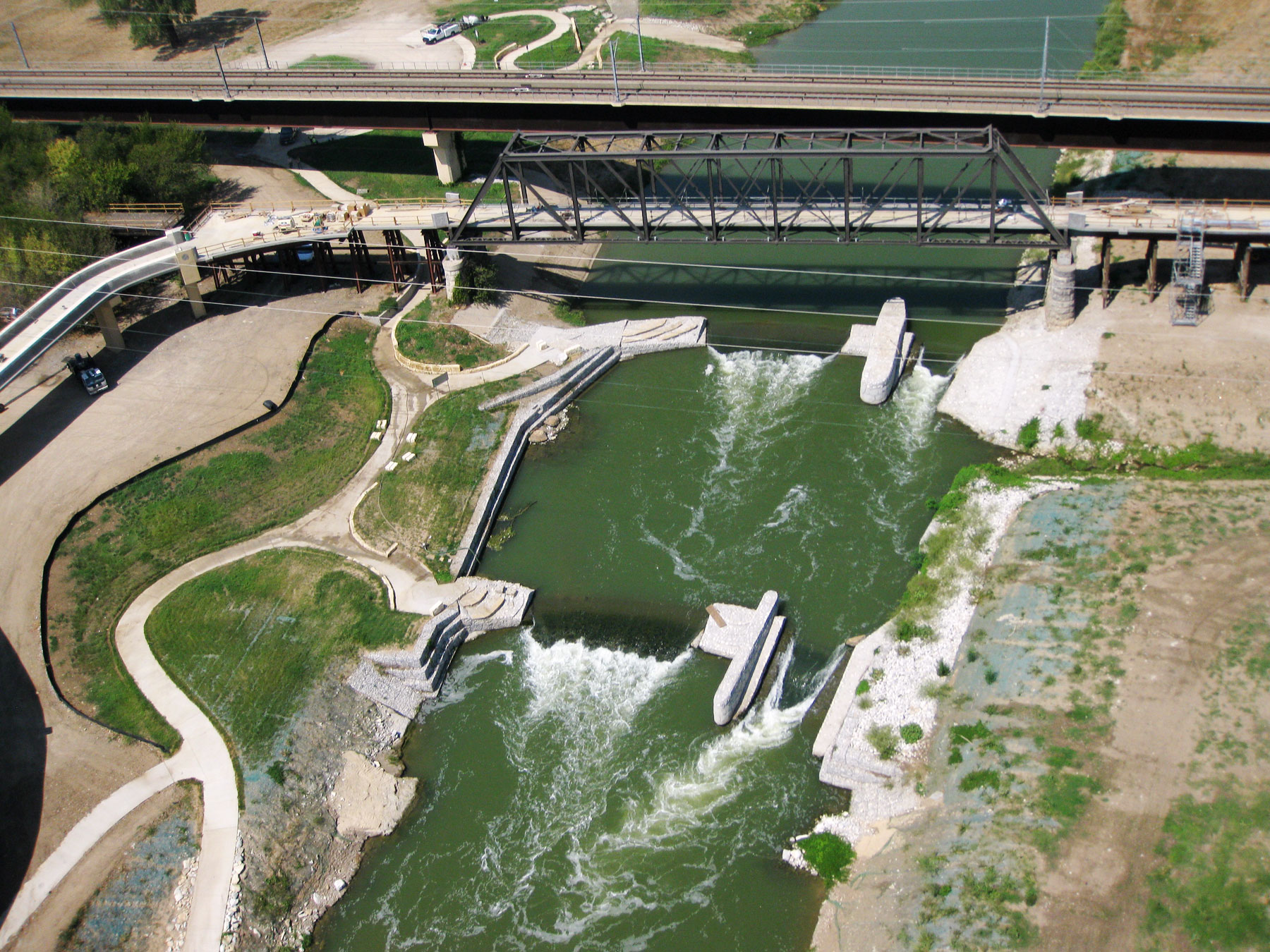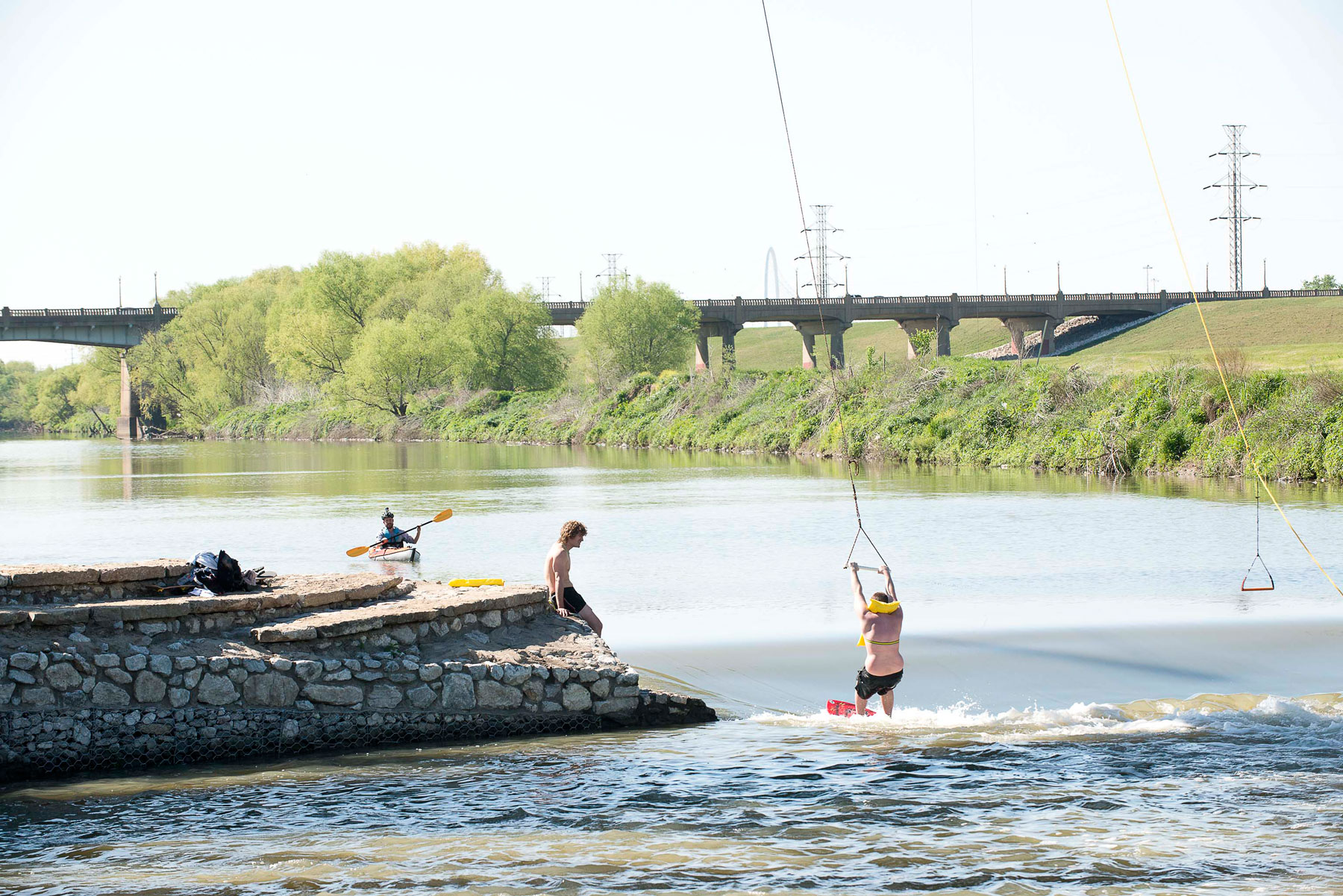A rushing river. With downtown’s glass towers on the horizon, that was the sound that greeted me when I opened my car door in the small gravel parking lot just upriver of the Dallas Wave. The Trinity River? Audibly and unmistakably rushing on a clear blue day in April? It was as unexpected as the cries of a baby in a bar.
The trunk of my Prius held the following: one high-volume, reversible-flow air pump; one Advanced Elements inflatable kayak (given to me by my mother some years ago as a birthday present); one Werner Skagit paddle (purchased at my own expense after receiving the kayak, which was pricey enough that Mom had said, “You’ll have to buy your own paddle”); one life vest (provenance unknown and, as I would learn, not adult-size); and one bicycle helmet (because who the hell in Dallas owns a white-water helmet?). The gear would facilitate a test of my theory that the river was perfectly safe, that fearmongering and not facts had led to talk that this stretch of the Trinity could kill people.

Had anyone died on the Dallas Wave? No. But a reasonable person reading the dispatches of the Dallas Observer’s Jim Schutze could be forgiven for thinking that it was only a matter of time before the Dallas Wave began killing people in such numbers that the corpses would dam up the river completely. Around the time of the park’s opening, Schutze began writing about a flaw in two bypass channels that were intended to provide tranquil passage around the waves. The bypasses were the opposite of tranquil. Schutze called them a “giant Cuisinart” and declared that if canoe-borne children weren’t wearing life jackets, they might drown in the bypasses, and even if they were wearing life jackets, “they would still get pushed underwater in one of the most toxic rivers in the state.” Later, in a story whose headline warned that the Dallas Wave “might kill canoers,” Schutze called the park “brutally dangerous.”
While the city tried to figure out who was responsible for turning the Trinity into a raging, murderous beast—was it the Colorado-based firm that designed the project, Recreation Engineering & Planning, or was it the local landscape architects who helped execute it, the folks from Arlington’s Schrickel, Rollins and Associates?—the Park Department kept the Dallas Wave closed. Funny thing about that: federal law says you can’t close a navigable river. Eventually the city was clued in to that fact, and in April, news trickled out that the white-water park had reopened. Anyone with a pure heart was welcome to sacrifice himself to the treacherous waters in the hope that the river might be placated and the rest of the city spared its wrath.
Honestly, I don’t have a pure heart. But I do have an inflatable kayak.
In April, news trickled out that the white-water park had reopened. Anyone with a pure heart was welcome to sacrifice himself to the treacherous waters in the hope that the river might be placated and the rest of the city spared its wrath.
The artichoke-green river flowed silently beneath my orange kayak. A DART train, startlingly loud, roared overhead on tracks that run parallel to the pedestrian Santa Fe Trestle. A quiet returned in the train’s wake, and then, into that quiet, came the white water, growing louder as I pointed my bow toward it.
To the left, the passage narrowed, and the river dumped into the bypass. My heart rate accelerated. I briefly wondered what Schutze would write about my drowning death, whether he would be respectful or go longform with his schadenfreude. Then I was through it—upright and still dry. Exhilarated, too.
I gave a fist pump to my associate on the bank. Death had been cheated! I pointed the kayak upriver and tried to row toward the first wave that I’d just bypassed. It was impossible, the river between the two waves flowing far too fast for my frail arms.
So back downriver and into the second wave, which I dominated in a way that actually made me feel sad for the river. There I was, a fortysomething man and father of two, inexperienced and wearing a too-small life vest that must belong to my son, shooting the rapids in a gift kayak from my mother, having a blast. Giant Cuisinart? Please. Brutally dangerous? If you consider the Waikiki Wipeout at Hawaiian Falls “brutally dangerous.”
Now, I did wind up getting fairly wet. Downriver of the second wave, I pulled up to the bank and (stupidly) handed the paddle to my associate—and was promptly swept downriver. I bailed out and sank up to my chest, bumping and grunting along for 25 yards or so before I managed to pull the kayak and myself out of the water. The pratfall made for a chuckle and some pretty good footage from the GoPro taped to my bike helmet.

As for the cops, they were just curious to see someone paddling the Dallas Wave, something they said they never see, even though the white-water park is on their beat. I stood on the bank, dripping, and chatted them up a bit. Two kids had skateboarded down the Santa Fe Trestle and thrown a tow rope over the railing so that the handle on the other end dangled 50 feet below, right in the first wave. They were now shirtless and shoeless, using the rope and a wakeboard to surf the wave. The cops didn’t mind at all.
I asked one, “Can you see this place covered with scores of people using the white-water park?”
He paused before answering and looked around. “Maybe in 20 years,” he said. “If they built this in Austin, it would be packed.”
And that’s where I wanted this story to end, with my theory proven correct and a smug smile on my face. But I made the mistake of calling some people to accept their congratulations on my brave feat. Willis Winters, the director of the Park Department, told me that the biggest problem with the Dallas Wave isn’t the danger it supposedly poses to people paddling downriver but the impediment it presents to anyone who might want to paddle upriver. Just as federal law prevents the city from closing the river, it stipulates that the river must remain navigable in both directions. The Trinity Watershed Management department has had to step into the mess, and it is now working to fix the bypasses with the Park Department and the Army Corps of Engineers and the contractors who designed the white-water park.
“Once we make it navigable upstream,” Winters said, “that will also address the issue that two or three people in the world have with the danger—quote unquote—of going downstream.”
Days later, I followed up with a question via email. Winters told me he couldn’t answer it because everything on the deal now has to go through the City Attorney’s Office. I’ll leave it to the reader to guess what that means. No, I won’t. My guess is that someone, somewhere is going to get sued.
I also talked to a guy named Eric Neilsen who is an avid paddler and a member and past vice president of the Dallas Downriver Club. Neilsen said that when it comes to Cuisinart action, the key factor is water volume. I’d performed my epic river run, the one that generations to come will talk about and analyze, on April 14, 2014, when the river was running at 545 cubic feet per second. That’s a little high. It had rained a couple days earlier. I had figured that the higher the water, the greater the danger. In this case, not so, Neilsen told me. The higher the water, the more distance between the surface and the riverbed features that create the turbulence. Neilsen said that at 350 to 400 cubic feet per second, where the river normally runs, the bypasses become harder to navigate. Too, my little kayak wouldn’t drag bottom at the Dallas Wave during a really low flow like a canoe would, which I knew but didn’t want to hear from a ponytailed smart aleck.

The EPA says that recreational water like the Trinity should not have more than 406 E. coli colony-forming units per 100 milliliters in any one sample, or more than 126 E. coli units in a 60-day, three-sample geometric mean average. Because you don’t remember what a geometric mean average is (in this case, the cube root of the product of three sample numbers) and because even I don’t know what a colony-forming unit of E. coli is, let’s just agree that when Neilsen told me he has measured 4,500 units of E. coli at the Dallas Wave, more than 10 times the EPA’s safe number, I offered the appropriate response: “Ick.” For the high numbers (that get even higher after rains) we can blame the birds, the feral hogs, and, of course, ourselves. Then there are the polychlorinated biphenyls and heavy metals (totally not the hogs’ fault).
I asked Neilsen to bottom-line it for me. He said, “The city has built a structure that they have not clued in the folks who are going to go down there and play as to what can be the consequences of that play.”
Allow me, then. Having thoroughly investigated the hydrodynamic and ecological characteristics of the Trinity River at the Dallas Wave, I suggest the Park Department run these words by the City Attorney’s Office posthaste so that they can be posted on a prominent sign on the riverbank:
“You should check the flow before you go. Google ‘USGS water flow 08057000,’ that number being the U.S. Geological Survey’s designation for the Trinity at Dallas. You should wear sunscreen. Yes, children without life jackets could drown in the Dallas Wave. But children without life jackets can drown in the bathtub. Do not drink the river. It is dirtier than any of us would like it to be. You playboat kayakers doing rolls and putting your heads underwater probably already know this, but you should wear nose clips and earplugs. And keep your eyes shut tight! As for you canoers who are trying to navigate upriver, we are terribly sorry. Dallas only realized about five years ago that it likes the Trinity River. We’re still trying to figure out how to be nice to it. Also, navigating downriver is easier. Just saying.”
Now see the video of Tim Rogers’ harrowing journey:






